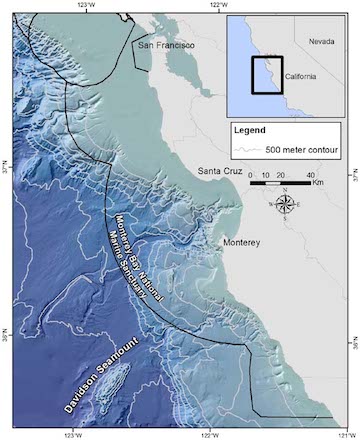400816-davidson.jpg

Davidson Seamount is located off the coast of central California. Credit: C. King, Monterey Bay National Marine Sanctuary
Volcanic mountains dot the west coast of the United States. Some are dormant, some are extinct — and some hide below the surface of the Pacific Ocean.
These underwater mountains are known as seamounts. And the first one ever listed as a seamount lies about 75 miles southwest of Monterey, California. It was discovered in 1933, and a few years later it was named for George Davidson, a leader in exploring America’s Pacific coast.
Davidson Seamount is enormous. It’s about 25 miles long, and it rises about a mile and a half from the ocean floor. Even so, its summit is almost a mile below the ocean surface.
The mountain formed between about 10 million and 16 million years ago, when molten rock bubbled up through a split between portions of the ocean floor. It was one member of a chain of volcanoes that stretched off the California coastline. All of those seamounts are still around today, although Davidson is the most studied.
A couple of expeditions in this century found that Davidson Seamount is teeming with life. Water currents around the mountain bring up nutrients from deep below the surface. The nutrients feed giant forests of coral and beds of sponges, both of which attach to the rocky surface atop the mountain. They act as “anchor” tenants — their presence attracts other organisms, such as crabs, shrimp, sea stars, and many species of fish. No other California seamount is known to host such a rich diversity of marine organisms — a profusion of life on a dead volcano.

